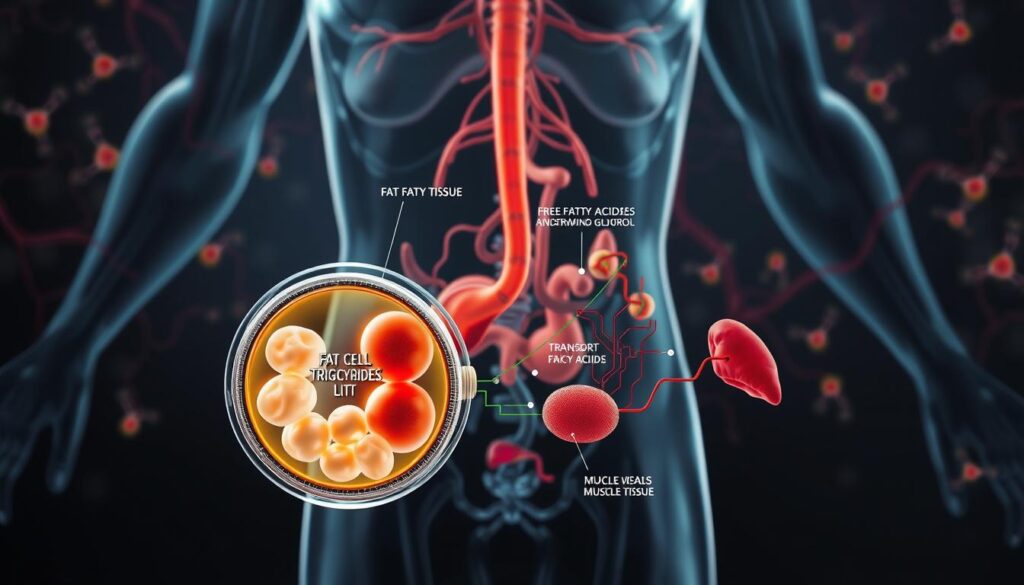Did you know that nearly 40% of adults in the United States are obese, according to the Centers for Disease Control and Prevention? This staggering statistic highlights the importance of effective weight management strategies. Achieving successful fat loss is not just about aesthetics; it’s about improving overall health and reducing the risk of chronic diseases.
A well-rounded approach to fat loss involves a combination of dietary changes, regular exercise, and lifestyle adjustments. This guide will walk you through the most effective methods to achieve your weight loss goals, providing you with a comprehensive roadmap to a healthier you.
Key Takeaways
- Understanding the importance of fat loss for overall health
- Learning effective dietary strategies for weight loss
- Discovering the role of exercise in achieving fat loss
- Making lifestyle adjustments to support weight management
- Setting realistic goals and tracking progress
Understanding the Science of Fat Loss
Unlocking the secrets of fat loss starts with understanding how your body utilizes fat for energy. When you grasp the biological processes involved, you’re better equipped to burn fat effectively and achieve your weight loss goals.
How Your Body Burns Fat
Your body burns fat through a process called lipolysis, where fat cells release fatty acids into the bloodstream. These fatty acids are then transported to the muscles, where they’re used as energy. This process is facilitated by various hormones, including adrenaline and noradrenaline, which play a crucial role in fat burning.
Caloric Deficit: The Foundation of Fat Loss
A caloric deficit is essential for fat loss. This means consuming fewer calories than your body burns, forcing it to use stored fat for energy. A well-planned caloric deficit helps you slim down while preserving muscle mass. Key strategies include:
- Reducing daily caloric intake
- Increasing physical activity
- Combining diet and exercise for optimal results
The Difference Between Fat Loss and Weight Loss
It’s crucial to distinguish between fat loss and weight loss. While weight loss refers to a reduction in overall body weight, fat loss specifically targets the reduction of body fat while preserving muscle mass. Focusing on fat loss ensures a healthier and more sustainable weight loss journey.

Nutrition Strategies for Effective Fat Loss
A well-structured nutrition plan is the cornerstone of any successful fat loss regimen. To get lean, one must focus on creating a sustainable diet that promotes fat burning while preserving muscle mass.
Calculating Your Optimal Calorie Intake
To shed pounds, you need to be in a caloric deficit, meaning you consume fewer calories than your body burns. Calculating your optimal calorie intake involves determining your basal metabolic rate (BMR) and adjusting it based on your activity level.
Macronutrient Balance for Fat Burning
A balanced diet is crucial for fat loss. It involves the right mix of protein, carbohydrates, and healthy fats.
Protein Requirements
Protein is essential for muscle preservation during fat loss. Aim for 0.8-1g of protein per pound of body weight. For example, if you weigh 150 pounds, your protein intake should be between 120-150 grams per day.
Carbohydrate Considerations
Timing carbohydrates around your workouts can enhance fat loss. Consuming carbs post-workout helps in muscle recovery and replenishes glycogen stores.
Healthy Fat Intake
Healthy fats are vital for hormone production and overall health. Sources include avocados, nuts, and olive oil. Aim to get 20-30% of your daily calories from healthy fats.
| Macronutrient | Recommended Daily Intake |
|---|---|
| Protein | 0.8-1g per pound of body weight |
| Carbohydrates | Timing around workouts |
| Healthy Fats | 20-30% of daily calories |
Meal Planning and Preparation Tips
Effective meal planning involves preparing meals in advance to ensure you’re meeting your nutritional goals. Focus on whole foods, including vegetables, lean proteins, and whole grains.
Hydration and Its Impact on Fat Metabolism
Hydration plays a significant role in fat metabolism. Adequate water intake helps in the breakdown of fats and supports overall metabolic health. Aim for at least 8-10 glasses of water per day.
By implementing these nutrition strategies, you’ll be well on your way to achieving your fat loss goals and maintaining a healthy, lean physique.
Exercise Protocols to Accelerate Fat Loss
Exercise plays a pivotal role in fat loss, and understanding the right protocols can significantly enhance your results. A well-rounded exercise regimen not only burns calories but also builds muscle, further accelerating your metabolism.
Strength Training for Body Composition
Strength training is a cornerstone of effective fat loss. By building lean muscle, you increase your resting metabolic rate, helping your body burn fat more efficiently.
Compound Movements for Maximum Results
Compound exercises such as squats, deadlifts, and bench presses are particularly effective. They engage multiple muscle groups, maximizing calorie expenditure and muscle growth.
For example, a squat works your legs, glutes, and core simultaneously, making it a highly efficient exercise for trimming down.
Rep Ranges and Rest Periods
The optimal rep range for strength training during fat loss is typically between 8-12 reps per set. This range balances muscle hypertrophy with strength gains.
Rest periods of 60-90 seconds between sets allow for adequate recovery while maintaining an elevated heart rate, contributing to calorie burn.
Cardiovascular Training Options
Cardiovascular exercise is another critical component of a fat loss regimen. It directly burns calories and improves cardiovascular health.
HIIT vs. Steady-State Cardio
High-Intensity Interval Training (HIIT) involves short bursts of intense exercise followed by brief rest periods. It’s highly effective for weight loss due to its high caloric expenditure and metabolic afterburn effect.
Steady-state cardio, on the other hand, involves maintaining a moderate intensity over a longer period. While effective, it generally burns fewer calories than HIIT.
Optimal Cardio Duration and Frequency
For HIIT, 20-30 minutes per session, 3-4 times a week, is a good starting point. Steady-state cardio can be done for 30-45 minutes, 3-4 times a week.
Sample Weekly Workout Plan for Fat Loss
A sample workout plan might include 3 days of strength training and 2-3 days of cardio. For example, you could do strength training on Monday, Wednesday, and Friday, and HIIT cardio on Tuesday and Thursday.
- Monday: Full-body strength training
- Tuesday: HIIT cardio
- Wednesday: Lower body strength training
- Thursday: HIIT cardio
- Friday: Upper body strength training
This plan allows for a balance of muscle building and burning fat, helping you achieve your weight loss goals.
Lifestyle Factors That Support Fat Loss
Beyond the realm of nutrition and physical activity, several lifestyle elements play a crucial role in supporting fat loss efforts. Achieving a leaner physique is not just about what you eat or how you exercise, but also about how other aspects of your lifestyle influence your body’s ability to lose fat.
Sleep Quality and Duration
Sleep is a critical factor in fat loss. Poor sleep quality and duration can disrupt hormones that regulate hunger and fullness, leading to increased calorie intake. Ensuring 7-9 hours of quality sleep per night is essential for supporting fat loss.
Stress Management Techniques
Chronic stress can hinder fat loss efforts by promoting the production of cortisol, a hormone that encourages fat storage around the midsection. Engaging in stress-reducing activities like meditation, yoga, or deep breathing exercises can help mitigate this effect.
Non-Exercise Activity Thermogenesis (NEAT)
NEAT refers to the energy expended on activities other than exercise, such as walking, fidgeting, or doing household chores. Increasing NEAT can help boost your metabolism and support fat loss. Simple changes like taking the stairs instead of the elevator or walking to work can make a significant difference.
Building Sustainable Habits
Developing habits that support fat loss is crucial for long-term success. This involves creating a routine that incorporates healthy eating, regular physical activity, and other lifestyle factors in a way that is sustainable over time. Consistency is key to achieving and maintaining a leaner physique.
| Lifestyle Factor | Impact on Fat Loss | Actionable Tips |
|---|---|---|
| Sleep Quality | Regulates hunger hormones | Ensure 7-9 hours of sleep per night |
| Stress Management | Reduces cortisol production | Practice meditation or yoga |
| NEAT | Boosts metabolism | Take the stairs, walk to work |
By incorporating these lifestyle factors into your daily routine, you can create a comprehensive plan that supports your fat loss goals and helps you achieve a healthier, leaner body.
Tracking Progress and Overcoming Fat Loss Plateaus
The key to successful fat loss lies not just in the initial weight loss, but in maintaining progress over time. As you continue on your journey to shed pounds, it’s crucial to have a robust system in place for tracking your progress and adjusting your strategy as needed.
Effective Methods to Track Body Composition
Tracking body composition is more informative than relying solely on weight scales. Methods include:
- Dual-energy X-ray absorptiometry (DEXA) scans
- Hydrostatic weighing
- Body fat calipers
These methods provide a more accurate picture of your fat loss progress by distinguishing between fat and lean body mass.
When and How to Adjust Your Approach
If you find your progress stalling, it may be time to reassess your diet and exercise routine. Consider adjusting your caloric intake or changing your workout regimen to include more strength training or high-intensity interval training (HIIT) to boost your metabolism.
Breaking Through Plateaus
Plateaus are a normal part of the fat loss journey. To overcome them, try changing your workout routine, adjusting your meal plan, or incorporating stress management techniques.
Common Mistakes to Avoid
Avoid common pitfalls such as:
Extreme Calorie Restriction
- : Severely limiting calories can lead to nutrient deficiencies and a slower metabolism.
Overreliance on Cardio
- : While cardio is beneficial, overdoing it can lead to muscle loss. Balance is key.
Neglecting Recovery
- : Adequate rest and recovery are crucial for muscle repair and overall progress.
By being aware of these potential issues, you can trim down effectively and sustainably.
Conclusion: Your Sustainable Fat Loss Journey
Embarking on a successful fat loss journey requires a comprehensive approach that incorporates nutrition, exercise, and lifestyle changes. By understanding the science behind fat loss and implementing effective strategies, you can achieve your weight loss goals and maintain a healthy, fat-burning body.
A well-planned nutrition strategy, combined with regular exercise and a balanced lifestyle, is key to burning fat and achieving sustainable weight loss. Focus on creating a caloric deficit, eating a balanced diet, and incorporating strength training and cardiovascular exercise to enhance fat burning.
By tracking your progress, overcoming plateaus, and maintaining a motivated mindset, you can ensure long-term success on your fat loss journey. With the right strategies and a commitment to your goals, you can achieve a healthier, leaner body and enjoy the benefits of a sustainable weight loss.
